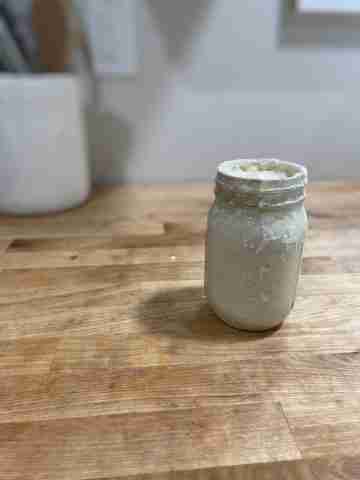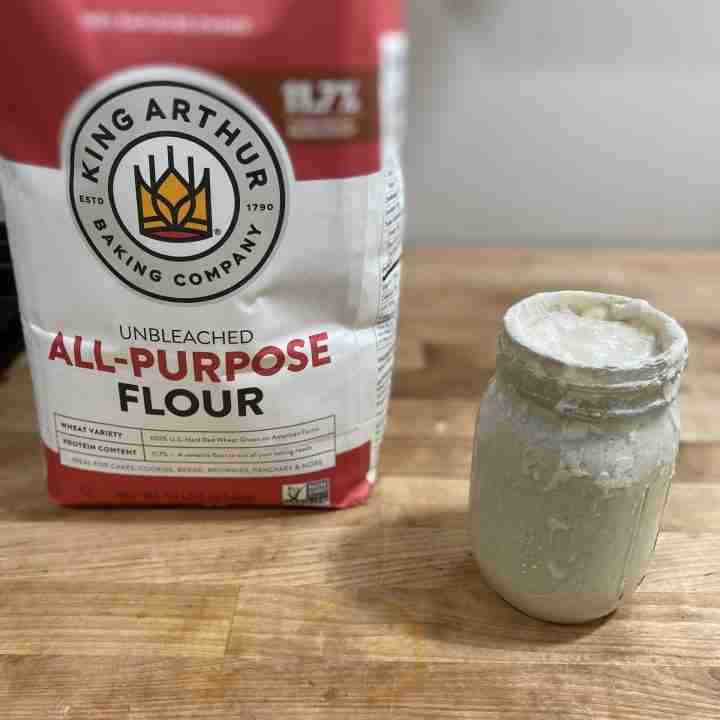Sourdough bread has been among the most popular trends in recent years, and it’s not hard to see why. In addition to the numerous health benefits it touts, sourdough bread is a relatively easy and inexpensive undertaking. Read on to learn more about how to make your very own sourdough starter and enjoy homemade artisan-style bread.

This post contains some affiliate links, which means I make a small commission at no extra cost to you. Read the full disclosure here.
What makes sourdough bread special?
While you’ve likely heard about sourdough bread, you might be wondering what makes it so special. Isn’t it just another kind of bread? No! Sourdough bread has several unique benefits that make it stand apart from most other kinds of bread.
Sourdough bread actually contains higher levels of severe vitamins, minerals and antioxidants than other kids of bread. It also contains lower levels of phytic acid than other kinds of bread.
Phytic acid is basically an anti-nutrient that is found in grains, seeds and nuts that actually interferes with the absorption of certain nutrients. It is present on grains in order to keep them from spoiling.
While there is a reason for the physic acid to be present, there is actually evidence that our bodies were not meant to handle it. And proper preparation of grains eliminates most, if not all, of the phytic acid in those grains.
So sourdough bread not only contains higher levels of nutrients than other kinds of breads, it also contains less phytic acid which allows our bodies to absorb more of those nutrients.
How to properly prepare grains
What is proper grain preparation, you ask? We can look to traditional cultures to find this answer.
Traditionally, most cultures would soak their grains prior to using and consuming them. This would allow for fermentation of the grains and the growth of native yeasts. Rather than using the instant yeast packets that our world is quick to use, these native yeasts can be used to provide a truly nutritious (and delicious!) bread.

How to make a sourdough starter
Now that you know why sourdough bread is special, you probably want to know how to make sourdough bread. To make sourdough bread, you need a sourdough starter (fermented, properly prepared grains that have produced native yeasts). Let’s make your sourdough starter!
Ingredients to make sourdough starter
- Flour
- Water
That’s it! You only need flour and water to make your sourdough starter!
Equipment to make sourdough starter
- Glass container – I like to use a mason jar
- Spoon or whisk
- Tea towel
Again, not very much at all! These are all things you likely already have on hand leaving no reason to put off making your sourdough starter.
Make your sourdough starter
The process to make a sourdough starter takes about 7 days to ensure that there is enough beneficial bacteria present in the starter. Here’s the process:
Day 1:
Combine 1/2 cup of flour and 1/2 cup of water in your glass container. Stir very well, making sure to incorporate all of the flour, scraping down the sides of the container. Cover with a tea towel and set aside for 24 hours.
Day 2:
On day 2, you will discard half of the mixture and repeat the steps from day 1. Add 1/2 cup of flour, 1/2 cup of water, stir well, cover and set aside.
Days 3-5:
Repeat the steps from day 2 for each of these days.
Days 6-7:
Repeat the same steps for days 6-7, but feed it every 12 hours rather than every 24 hours.
Buy day 7, your sourdough starter should be ready to use for all sorts of delicious baked goods! You will know if it’s ready if it bubbles and doubles in size after feeding.
FAQ’s
Why do we discard half of the starter?
Discarding half of the starter prior to feeding it ensures that you don’t have an overflow of starter. If you didn’t discard any starter, you would have an overabundance of starter. Discarding also ensures that the right amount of flour and water if feeding your starter. Without discarding any of the starter, the 1/2 of flour wouldn’t be enough to feed your starter and you would never get a fully mature sourdough starter.
How do I maintain my sourdough starter?
To maintain your starter, I recommend storing it in the refrigerator. This slows down the fermentation process so one feeding a week is sufficient.
When you want to use your starter, simply remove it from the refrigerator and feed it 12-24 hours before use. Remove what you need for your recipe, then place the starter back in the refrigerator until your next use / feeding.
Another option is to store it on the counter. However, this would require you to feed the starter daily and would result in an overabundance of starter / discard. This would really only be needed if you were running a bakery or making enough baked goods to use all of that discard.
What can I make with my sourdough starter?
So many things! Breads, cookies, pancakes, bagels, English muffins. The list goes on! Basically, if it is a baked good, it can be made with sourdough starter. Stay tuned for more recipes!
Did you try this recipe
I would be so grateful if you left a rating and review below!

Sourdough Starter
Learn to make your very own sourdough starter and enjoy the many health benefits (and the delicious taste!)
Ingredients
- Flour (whole grain or unbleached all-purpose are great options)
- Water
Instructions
- On day one, combine 1/2 cup flour and 1/2 cup water in a glass container, stir well, scraping down the sides of the container. Cover and set aside for 24 hours.
- On day two, discard half of the starter, add 1/2 cup of flour and 1/2 cup of water, stirring well. Cover and set aside for 24 hours.
- On days 3-5, repeat the process from day 2 each day.
- On days 6-7, repeat the process from day 2 but feed the starter every 12 hours rather than every 24 hours.
- By day 7 your starter shoud be ready to use! You will know it is ready when it bubbles and doubles after feeding.
Notes
Why do we discard half of the starter?
Discarding half of the starter prior to feeding it ensures that you don't have an overflow of starter. If you didn't discard any starter, you would have an overabundance of starter. Discarding also ensures that the right amount of flour and water if feeding your starter. Without discarding any of the starter, the 1/2 of flour wouldn't be enough to feed your starter and you would never get a fully mature sourdough starter.
How do I maintain my sourdough starter?
To maintain your starter, I recommend storing it in the refrigerator. This slows down the fermentation process so one feeding a week is sufficient.
When you want to use your starter, simply remove it from the refrigerator and feed it 12-24 hours before use. Remove what you need for your recipe, then place the starter back in the refrigerator until your next use / feeding.
Another option is to store it on the counter. However, this would require you to feed the starter daily and would result in an overabundance of starter / discard. This would really only be needed if you were running a bakery or making enough baked goods to use all of that discard.
What can I make with my sourdough starter?
So many things! Breads, cookies, pancakes, bagels, English muffins. The list goes on! Basically, if it is a baked good, it can be made with sourdough starter. Stay tuned for more recipes!

Leave a Reply